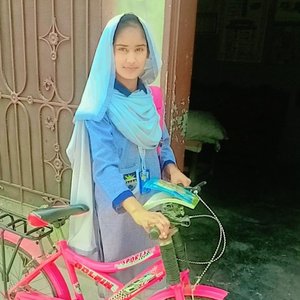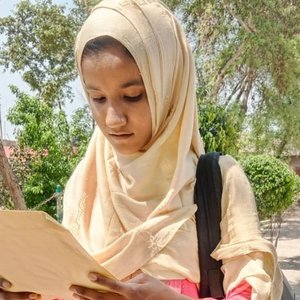How global communities thrive when girls realize their full potential — an episode with the Boss Ladies Podcast
Manasi Gajjalapurna and Sualeha Irshad discuss with girls from India, Peru and Sri Lanka the importance of educating and empowering young women around the world. (Courtesy of Manasi Gajjalapurna and Sualeha Irshad)
Manasi Gajjalapurna and Sualeha Irshad discuss with girls from India, Peru and Sri Lanka the importance of educating and empowering young women around the world.
Investing in young women is vital to achieving a sustainable future.
When we fill opportunity gaps and help young women reach their full potential, countries experience social and economic gains — including increased labor force participation and decreased intergenerational poverty.
We started The Boss Ladies Podcast to help young women realise their ambitions by democratising global access to information. Through interviews with inspiring women activating change, we hope to share powerful insights with other girls around the world (we currently have listeners in 32 countries!). Our episodes cover everything from developing low-cost prosthetics to girls’ political empowerment and seek to crowdsource knowledge and build connection through shared experiences.
Today, we invited three Assembly readers from India, Peru and Sri Lanka to hold a conversation on the economic implications of girls’ education within their communities and the importance of women’s participation in the labour force.
Anisha Roy Bhatia is a 16-year-old student from India who is passionate about providing inclusive academic spaces for girls that prioritise their safety and enable them to join India’s formal working sector, which has one of the lowest rates of female participation in the world.
Victoria Segura Béjar (Jimena) is an 18-year-old changemaker from Peru and is the founder of Imasion.org, a platform focused on gender equality that uses animations, kits and local programmes to educate youth on emerging science and sustainability.
And Zainab Rubaith is an 18-year-old activist from Sri Lanka, who speaks out about reforming religious norms and stereotypes about girls’ education in her country.
Our conversation covers the economic benefits of girls’ education and how people in power can better help young women realise their full potential. You can listen to the full episode here and read a condensed transcript below.
“When we're not employing women, we're seeing increases in domestic violence and financial dependence. So many things can be linked to the fact that girls and women aren't able to access education,“ Anisha shares. (Courtesy of Manasi Gajjalapurna and Sualeha Irshad)
Sualeha Irshad (SI): What do you think are the economic benefits of girls' education and how has education personally empowered you?
Anisha Roy Bhatia (ARB): Girls' education is so important because it allows for girls and women to be part of the country's workforce. In India, a big percentage of our women are actually involved in the informal working sector or the shadow sector of India. They are women who work in households as cooks or clean houses where they are not formally paid and don't have taxable jobs. Because nothing's identifiable to say that they're employed within our country, a lot of women don't have their rights protected. Educating girls will allow them to be a part of the formal working sector, which is so important, especially in such a large country like India.
When we're not employing women, we're seeing increases in domestic violence and financial dependence. So many things can be linked to the fact that girls and women aren't able to access education. That's why education is just so empowering for me. Just knowing that you have that ability to one day grow up, get a job and say, “I'm financially stable.” But when we refuse to give our girls and women the education that they require, it becomes 10 times more difficult for them to be a part of the workforce and just depend on themselves for their own income.
Zainab Rubaith (ZR): I’m from Sri Lanka and I come from a very orthodox, very typical Muslim community. All I heard growing up from closely related people of mine was that girls belong to the kitchen and it would be much more useful if they would learn how to cook and clean rather than spend any amount of money for their education. “What's the point of higher education anyway?” “At the end of the day, she's going to be married off, live on her husband's providing and build a family.” Every time someone said anything like this, they always added that this is what Islam says and is how we should live by.
That's why my education empowered me to take things into my own hands and find the truth about what Islam truly is. I discovered this huge respect for Islam. But this also made me very furious, because I now know that my community had such a false idea of Islam and has been teaching it in such a wrong way for almost decades now.
So now my education has given me the awareness to know that something was wrong in the first place. And the idea that I had to figure it out on my own rather than following the crowd.
It also gave me the strength, resources and courage to raise my voice in places where others should have done so long ago.
Victoria Segura Béjar Jimena (VSBJ): In Peru, especially in rural areas, girls don’t go to schools because they are girls. This is because there is a lack of education and an issue in the way we are creating education. In rural areas, there is a digital gap. If we don’t teach students with technological resources, we are not developing their critical and creative minds. Also, we should provide technological tools with guidance from mentors and tutors and focus on low-income communities. So it’s important we empower these communities with technology.
“[My education] gave me the strength, resources and courage to raise my voice in places where others should have done so long ago.”
Manasi Gajjalapurna (MG): Do you feel like your community invests in girls' education? And how has your community's investment or lack thereof impacted girls' empowerment and access to opportunities?
ARB: My community invests in girls' education to an extent. However, being in a country as large as India, it's really difficult to empower every single girl in the country. And that's where the problem really arises, where there's a big percentage of the population who can afford our own education. Girls like me receive the education that we require. But with so many of the girls that I've worked with in the past, the biggest thing that I've realised is that their parents can't afford to pay their school fees. And when it comes to not being able to afford to pay their school fees, if the parents have a son, they often will choose to educate the son before they choose to educate their daughter.
That's one of the biggest problems that we have. Also, I think a lot of the people involved in our educational system here don't really encourage girls and women to pursue their ambitions as much as they'd pursue a boy. Families and teachers will encourage something that doesn't require too much of your time to be taken so that you can give enough of your time to your family and take care of your household.
“When we refuse to give our girls and women the education that they require, it becomes 10 times more difficult for them to be a part of the workforce and just depend on themselves for their own income.”
I live in Bombay, which is one of the most urban cities and the commercial capital of India. But when you look at it, you'll see that the smaller regions don't have safe methods of transport for young girls. So a lot of parents don't send their girls to schools if they're hours away because they're afraid about what will happen to their daughter when she's gone to school. And I think that's such a big pertinent issue of just the safety of girls within India. Even in a city like Bombay, parents will think twice or thrice before sending their girls to schools because what if she doesn't come back and or what if she's hurt? Or what if something happens to her? That's where our community needs to really invest. Not only in educating people about the importance of girls' education, but also in really building safe mechanisms and infrastructure for girls to be educated.
VSBJ: It is true that there is more investment in ed-tech startups, especially those that focus on girls’ education in various areas, like social science, and technological tools to empower girls and low-income communities. But they need investments. Local governments are not in my area and in Peru there is no investment in girls’ education. Girls and boys have to walk long distances just to go to school. This is the reality. But there are solutions. For example, we can invest money in start-ups, partners in rural areas and especially invest in our focus on girls’ education.
ZR: The Sri Lankan government provides free schooling and whoever attends a public or a government school never have to pay for their education. The same applies for universities. And I think this is one of the biggest reasons why many girls love to go to school. But even though it’s a huge advantage, I would not say that my community invests in girls’ education. Because I think there’s a huge difference. It’s not about just having a school. It’s about what you choose to do with it and how you give that to each individual. As much as I would like to say, yes, my community very much invests in girls’ education, the reality says otherwise.
As Aneesha said, it’s truly a very big problem when it comes to the safety of girls. If they’re having problems with a certain subject in school and their parents could afford anything, they would not be willing to send that girl for an extra session, because they’re truly concerned about the girl’s safety. Unless someone from a family is with her, the family cannot stay at home. I think that’s one of the very big reasons in my community why women are slowly losing touch with the core of education.
“Education should have technological access, with exploration in rural areas to solve local problems and provide tools and mentorship.”
SI: What types of investments do you wish to see outside of your community, within your country or globally that you think would allow women to thrive in any environment?
ARB: The kind of investments that I would like to see would definitely be more role models. I think that’s one of the biggest things that a lot of us girls lack. Just last year, I was a part of a fellowship program, where it was an all-girls environment with professionals talking to us about the industries they work in and their journeys to success. And that’s so important because that inspired me and it can inspire other young girls. I know it’s not that simple, but we’re telling girls that they do have a place in society and in the working sector.
Also, we need female-centric spaces for studying. There’s a variety of variables beyond just ‘I want to send my girl to a school.’ In rural areas, especially in India or with families that may not be comfortable having their girl children going to co-ed schools, having female-centric spaces will encourage families to send their girls to school.
VSBJ: Greater investment in tech start-ups. For example, in England, a company created a video game for girls called “Erase All Kittens.” They teach basic coding and also empower through educational programs, with their focus on refugees and girls. This kind of focus can be replicated in multiple countries. Also, it is important to teach girls about technology and STEM areas with a focus on social skills like leadership and how to express your ideas, problem-solving, workshops and bootcamps.
There is a huge digital gap and the Minister of Education in Peru is not investing in these kinds of solutions. Another huge problem is corruption. Many people think that it is important to invest and partner with NGOs, but how can we do this if there is corruption in the local government, municipalities and the Peruvian government?
“It is important to teach girls about technology and STEM areas with a focus on social skills like leadership and how to express your ideas, problem-solving, workshops and bootcamps.”
So there are a lot of challenges, but we can address short-term and long-term solutions. For example, take advantage of the rural areas. Children can be in contact with real problems and through mentorships and bootcamps and can think about how to solve them. So, we should make education more sensitive for them and connect with their areas. Also, we should include in school curriculum education skills, like problem-solving, which can empower them. So, building a new kind of educational program, and with teachers. Because there are teachers who don’t know how to use a computer, a tablet and technological resources for their classes. This is a challenge that the Minister of Education in Peru doesn’t talk about and should try to solve.
Education should have technological access, with exploration in rural areas to solve local problems and provide tools and mentorship. It’s also important to think of how to empower future generations with these tools.
This conversation has been condensed for clarity.
 Read more
Read more













